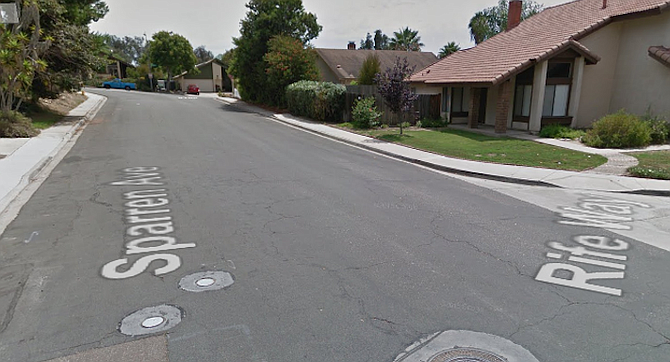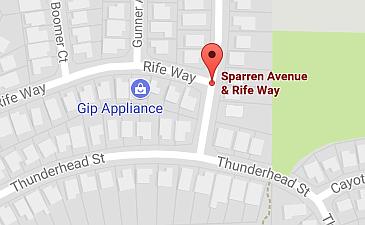 Facebook
Facebook
 X
X
 Instagram
Instagram
 TikTok
TikTok
 Youtube
Youtube

Some Rancho Peñasquitos residents who were pleased to see yellow wheelchair ramps put in at the corner of Rife Way and Sparren Avenue were astounded days later when city crews showed up and installed ‘No Pedestrian Crossing’ signs with chains next to the ramps.

“It’s completely ridiculous, and it’s an eyesore,” says Dick Sylva, who lives on the corner. “We were glad to see the ramps but the signs are just silly.”
Requests to the city on July 19 and 20 did not garner an explanation from the city. (If I receive one, I will post it in the comments section.)
It appears that the signs mean pedestrians are allowed to cross Rife Way, but forbidden to cross Sparren Street at the T intersection. The signs are made of two poles sunk into the cement, with chains hung horizontally between them, along with the ‘No Pedestrian Crossing’ sign. But the ramps with the bumpy yellow mats, seem to push pedestrians out onto Sparren anyway.

“This is a residential neighborhood, it isn’t Mira Mesa Boulevard or Black Mountain Road,” Sylva added.
The signs appear to direct pedestrians a few hundred feet (south) to another T intersection, where they can cross from one side of Sparren to the other. Following the city’s logic, their next choice to cross the street is at Carmel Mountain Road, about a third of a mile away up and over a hill. It is the only four way intersection with marked crosswalks along the entire street — though there are four T intersections between Thunderhead and Carmel Mountain, where Sparren begins and ends.
“My wife is in a wheelchair and they want her to either cross there (at Thunderhead and Sparren), where traffic can’t see her, or to have me push her wheel chair a quarter of a mile up that big hill and back down,” Sylva said. “This is just ridiculous.”
Julie Adams, who lives nearby, and Sylva have organized the neighborhood since the signs were put in a few months ago. So far they’ve talked to their city council office and to the city’s Traffic Engineering Department. The city engineers told residents that they can’t put a legal crossing at Rife because it would impede residents’ private walkways and driveways. The Americans with Disabilities Act requires the city to meet high standards, they said,
According to Adams, city Transportation and Stormwater employee Bill Harris who may yet be a senior public Information officer, told them that if a crossing doesn’t meet ADA standards, they have to block the crossing.
But that’s not what Adams learned when she read up the subject. To make his point, Harris had shown her treatments for traffic islands that are being designed and built now. But the street was built with the rest of the neighborhood in the 1970s and had no traffic islands.
In her research, she discovered the ADA is flexible in its retrofitting requirements.
“They have to make things as accessible as feasible in retrofitting,” Adams said. “That’s the requirement. They have to do the most they can to make it accessible to as many people as possible.”
Adams went out and looked at 70 other T intersections that were fitted with ramps at the same time Sparren was, in Allied Gardens and and found none of them got the signs. Not one, she says.
“In University City, of 20 T intersections, seven are like ours but with no signs,” she said. “Sixteen of 27 in Allied Gardens were like ours, curbs cut on two corners and none on the cross street. No signs.”
Rife and Sparren are a particularly safe place for kids on the way to school to cross, neighbors say. The intersection at Thunderhead is sloped so that cars making right turns onto Sparren have poor visibility. Failure to yield to pedestrians is one of the most common crash causes, and one of the worst for the pedestrian, according to National Highway Transportation Safety Administration reports.
“It’s crazy — this makes it illegal to let kids cross at a safe place and send them to a dangerous unmarked crosswalk,” Adams said. “In every way, it makes no sense and it looks horrible.”
It’s not the cut curbs that bother the neighbors. It’s the poles and chains and the message — all more appropriate for El Cajon Boulevard than a residential area.
“This sign was just a mistake,” Adams said. “I wish they would just correct the mistake.”


Some Rancho Peñasquitos residents who were pleased to see yellow wheelchair ramps put in at the corner of Rife Way and Sparren Avenue were astounded days later when city crews showed up and installed ‘No Pedestrian Crossing’ signs with chains next to the ramps.

“It’s completely ridiculous, and it’s an eyesore,” says Dick Sylva, who lives on the corner. “We were glad to see the ramps but the signs are just silly.”
Requests to the city on July 19 and 20 did not garner an explanation from the city. (If I receive one, I will post it in the comments section.)
It appears that the signs mean pedestrians are allowed to cross Rife Way, but forbidden to cross Sparren Street at the T intersection. The signs are made of two poles sunk into the cement, with chains hung horizontally between them, along with the ‘No Pedestrian Crossing’ sign. But the ramps with the bumpy yellow mats, seem to push pedestrians out onto Sparren anyway.

“This is a residential neighborhood, it isn’t Mira Mesa Boulevard or Black Mountain Road,” Sylva added.
The signs appear to direct pedestrians a few hundred feet (south) to another T intersection, where they can cross from one side of Sparren to the other. Following the city’s logic, their next choice to cross the street is at Carmel Mountain Road, about a third of a mile away up and over a hill. It is the only four way intersection with marked crosswalks along the entire street — though there are four T intersections between Thunderhead and Carmel Mountain, where Sparren begins and ends.
“My wife is in a wheelchair and they want her to either cross there (at Thunderhead and Sparren), where traffic can’t see her, or to have me push her wheel chair a quarter of a mile up that big hill and back down,” Sylva said. “This is just ridiculous.”
Julie Adams, who lives nearby, and Sylva have organized the neighborhood since the signs were put in a few months ago. So far they’ve talked to their city council office and to the city’s Traffic Engineering Department. The city engineers told residents that they can’t put a legal crossing at Rife because it would impede residents’ private walkways and driveways. The Americans with Disabilities Act requires the city to meet high standards, they said,
According to Adams, city Transportation and Stormwater employee Bill Harris who may yet be a senior public Information officer, told them that if a crossing doesn’t meet ADA standards, they have to block the crossing.
But that’s not what Adams learned when she read up the subject. To make his point, Harris had shown her treatments for traffic islands that are being designed and built now. But the street was built with the rest of the neighborhood in the 1970s and had no traffic islands.
In her research, she discovered the ADA is flexible in its retrofitting requirements.
“They have to make things as accessible as feasible in retrofitting,” Adams said. “That’s the requirement. They have to do the most they can to make it accessible to as many people as possible.”
Adams went out and looked at 70 other T intersections that were fitted with ramps at the same time Sparren was, in Allied Gardens and and found none of them got the signs. Not one, she says.
“In University City, of 20 T intersections, seven are like ours but with no signs,” she said. “Sixteen of 27 in Allied Gardens were like ours, curbs cut on two corners and none on the cross street. No signs.”
Rife and Sparren are a particularly safe place for kids on the way to school to cross, neighbors say. The intersection at Thunderhead is sloped so that cars making right turns onto Sparren have poor visibility. Failure to yield to pedestrians is one of the most common crash causes, and one of the worst for the pedestrian, according to National Highway Transportation Safety Administration reports.
“It’s crazy — this makes it illegal to let kids cross at a safe place and send them to a dangerous unmarked crosswalk,” Adams said. “In every way, it makes no sense and it looks horrible.”
It’s not the cut curbs that bother the neighbors. It’s the poles and chains and the message — all more appropriate for El Cajon Boulevard than a residential area.
“This sign was just a mistake,” Adams said. “I wish they would just correct the mistake.”
Comments